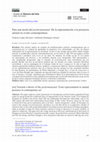Papers by Rodriguez Guillermo

Anales de Historia del Arte nº 31 (2021), 431-453., 2021
Este artículo analiza un conjunto de manifestaciones artísticas contemporáneas que se ... more Este artículo analiza un conjunto de manifestaciones artísticas contemporáneas que se caracterizan por su voluntad de aprehender la naturaleza viva, desbordando, con ello, las lógicas tradicionales de la representación en Occidente. Si bien el arte europeo parece haber tenido siempre presente la problemática relación vida/naturaleza/arte, no fue hasta el siglo XX que algunos artistas comenzaron a introducir seres vivos en sus obras. No obstante, los modos en que lo vivo puede ser representado son diversos, y sus resultados muchas veces inesperados. Para aproximarnos a esta complejidad, proponemos aquí el concepto de performanymal como herramienta que nos permite abordar una serie de iniciativas artísticas que, en sintonía con ciertas corrientes filosóficas neovitalistas y nuevos paradigmas de la biología, tratan de hacer comparecer la vida en lugar de intentar representarla mediante indicios, símbolos, o reducciones objetivas. Nuestro estudio profundiza en tres manifestaciones artísticas clave de la historia del arte europeo (el cine surrealista-científico de Jean Painlevé, las performances de Walter Marchetti y el Grupo Zaj, y el arte de situaciones en curso de Pierre Huyghe) que comparten un marcado interés por ahondar en nociones como el error, el azar, el devenir, y el juego –parámetros que reformulan la lógica de la representación en favor de una concepción de la naturaleza como realidad en movimiento que excede todo determinismo y pone en tela de juicio ciertas categorías heredadas del arte y la filosofía occidentales.
Palabras clave: Arte vivo; animalidad; bioarte; presencia; representación; performanymal; animot.
[en] Towards a theory of the performanymal. From representation to animal presence in contemporary artAbstract. This paper analyzes certain expressions of contemporary art that intend to apprehend living nature by going beyond the traditional logic of representation in the Western world. Even though the European art tradition has always dealt with the challenging life/nature/art relationship, only in the 20th century did artists start representing living beings in their works. However, many are the ways in which the living can be represented, and so are their –mostly unexpected– results. In this paper we resort to the concept of performanymal, asserting it as a tool that allows us to approach a number of initiatives that, in line with certain philosophical neovitalist currents and innovative biology paradigms, make an attempt to make the living «present» instead of trying to represent it via signs, symbols, or objective reductions. This paper lays out a study focusing on three key manifestations in the history of European art (Jean Painlevé’s surrealist-scientific cinema, the performative actions by Walter Marchetti and The Zaj Group, and Pierre Huyghe’s «live situations») that share an interest in delving into error, randomness, and play –notions that speak of nature as a dynamic reality that exceeds all determinisms, thus calling into question certain artistic and philosophical categories of the Western tradition.
Keywords: Animality; living art; bioart; presence; representation; performanymal; animot.











Uploads
Papers by Rodriguez Guillermo
Palabras clave: Arte vivo; animalidad; bioarte; presencia; representación; performanymal; animot.
[en] Towards a theory of the performanymal. From representation to animal presence in contemporary artAbstract. This paper analyzes certain expressions of contemporary art that intend to apprehend living nature by going beyond the traditional logic of representation in the Western world. Even though the European art tradition has always dealt with the challenging life/nature/art relationship, only in the 20th century did artists start representing living beings in their works. However, many are the ways in which the living can be represented, and so are their –mostly unexpected– results. In this paper we resort to the concept of performanymal, asserting it as a tool that allows us to approach a number of initiatives that, in line with certain philosophical neovitalist currents and innovative biology paradigms, make an attempt to make the living «present» instead of trying to represent it via signs, symbols, or objective reductions. This paper lays out a study focusing on three key manifestations in the history of European art (Jean Painlevé’s surrealist-scientific cinema, the performative actions by Walter Marchetti and The Zaj Group, and Pierre Huyghe’s «live situations») that share an interest in delving into error, randomness, and play –notions that speak of nature as a dynamic reality that exceeds all determinisms, thus calling into question certain artistic and philosophical categories of the Western tradition.
Keywords: Animality; living art; bioart; presence; representation; performanymal; animot.
Palabras clave: Arte vivo; animalidad; bioarte; presencia; representación; performanymal; animot.
[en] Towards a theory of the performanymal. From representation to animal presence in contemporary artAbstract. This paper analyzes certain expressions of contemporary art that intend to apprehend living nature by going beyond the traditional logic of representation in the Western world. Even though the European art tradition has always dealt with the challenging life/nature/art relationship, only in the 20th century did artists start representing living beings in their works. However, many are the ways in which the living can be represented, and so are their –mostly unexpected– results. In this paper we resort to the concept of performanymal, asserting it as a tool that allows us to approach a number of initiatives that, in line with certain philosophical neovitalist currents and innovative biology paradigms, make an attempt to make the living «present» instead of trying to represent it via signs, symbols, or objective reductions. This paper lays out a study focusing on three key manifestations in the history of European art (Jean Painlevé’s surrealist-scientific cinema, the performative actions by Walter Marchetti and The Zaj Group, and Pierre Huyghe’s «live situations») that share an interest in delving into error, randomness, and play –notions that speak of nature as a dynamic reality that exceeds all determinisms, thus calling into question certain artistic and philosophical categories of the Western tradition.
Keywords: Animality; living art; bioart; presence; representation; performanymal; animot.